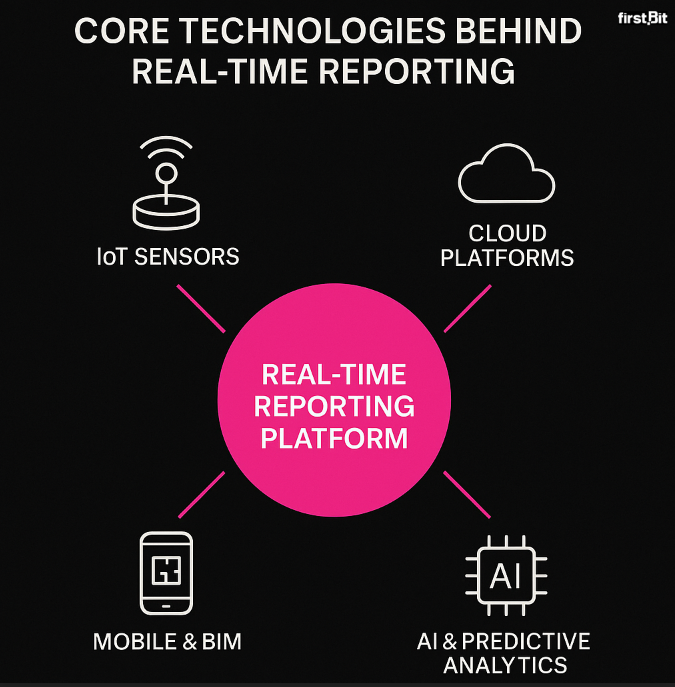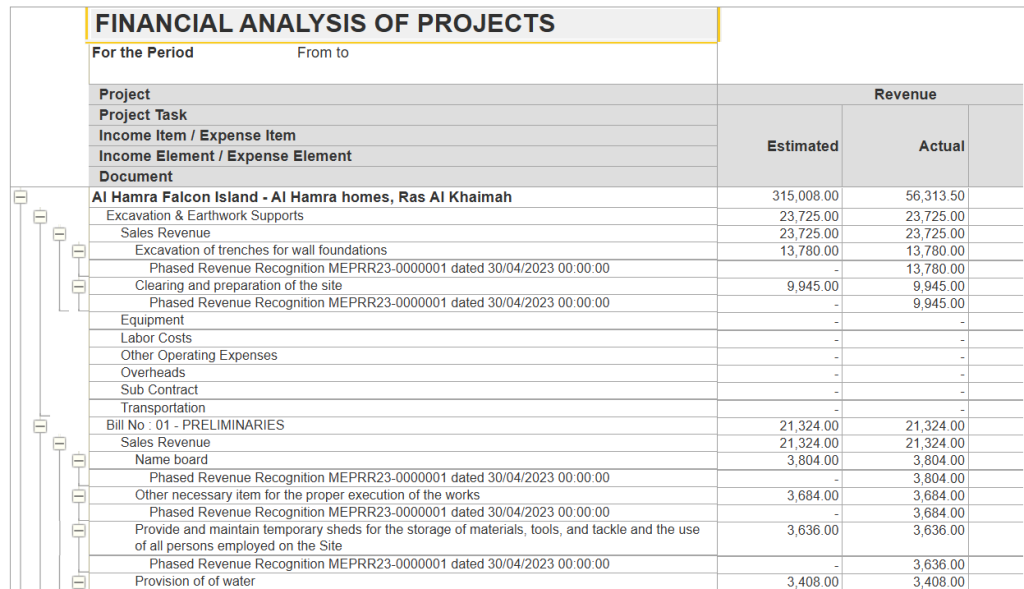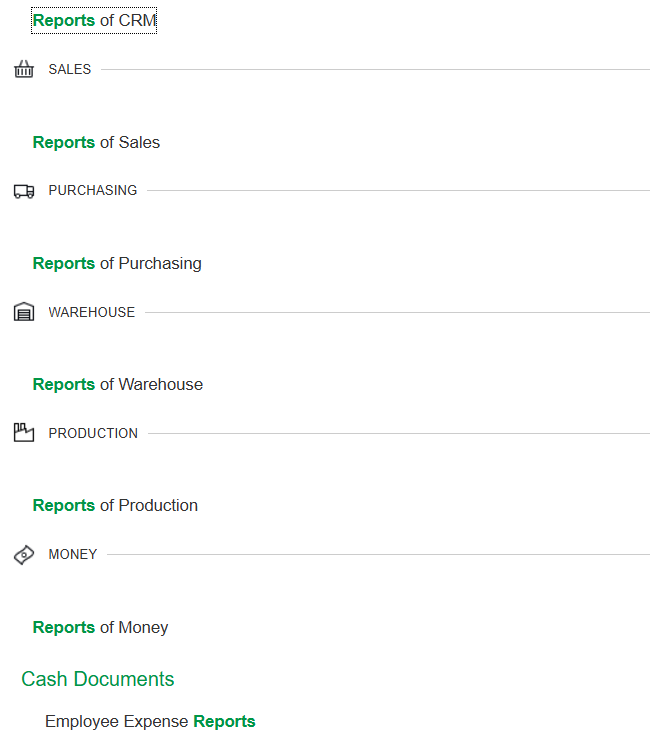The construction industry is under constant pressure to deliver projects faster, safer, and within budget. Yet outdated reporting practices like paper logs, end-of-day updates, and scattered spreadsheets remain common across many sites. These slow information flows create blind spots that make it harder for managers to react to issues before they escalate.
This is where real time reporting in construction is changing the game.
45% of project owner respondents say they have experienced a schedule delay or cost impact of more than 20 percent[?].
Real-time reporting addresses this by providing continuous visibility into project conditions. Instead of relying on outdated data, managers and clients gain live updates on progress, costs, and risks. The result is faster, fact-based decision-making that improves collaboration, minimizes disputes, and helps projects stay on track.
What Is Real Time Reporting in Construction
Real time reporting in construction is the process of continuously collecting, processing, and sharing live project data from the field.
Instead of relying on paper-based logs, phone calls, or end-of-day summaries, site conditions are monitored digitally, and updates are instantly transmitted to all stakeholders. This ensures that decision-makers always have the most accurate picture of what’s happening on-site.
A real time reporting tool typically brings together data on workforce attendance, equipment usage, material deliveries, and financial updates into one shared platform.
Example: When a delivery truck is delayed or a piece of equipment breaks down, supervisors don’t have to wait until the next meeting to act. With real time data monitoring, alerts can be sent immediately, and corrective actions can be taken before the issue escalates into a costly delay.
Why Real Time Reporting Matters
What makes real time reporting powerful is its ability to create a digital feedback loop between the jobsite and the office.
Project managers, engineers, and even clients can access the same real time information in construction through dashboards or mobile apps. This transparency eliminates miscommunication, shortens approval cycles, and builds accountability across teams.
In essence, real time reporting transforms construction management from reactive to proactive. By replacing assumptions with live data, companies can:
Core Technologies Enabling Real-Time Reporting in Construction
Main technologies behind real time reporting
Behind every successful real-time reporting tool lies a set of interconnected technologies that make continuous monitoring and instant feedback possible. These solutions turn raw site data into actionable insights that project managers, contractors, and clients can access in seconds.
IoT Sensors
Internet of Things (IoT) sensors are at the heart of real-time data monitoring. They track site conditions such as temperature, humidity, vibration, and equipment usage.
In construction, IoT devices are commonly attached to:
-
Heavy machinery
-
Safety helmets
-
Material storage areas
They automatically feed data to central dashboards, reducing the need for manual inspections.
Example: Vibration sensors can detect unsafe operating levels in cranes or excavators, alerting operators before a mechanical failure occurs. Similarly, wearable devices can monitor workers’ movement patterns to ensure compliance with safety protocols.
Cloud Platforms
Cloud platforms make it possible to store, process, and share vast amounts of project data securely and instantly. They synchronize information between the site and the back office so that everyone — from supervisors to finance teams works with the same dataset.
Cloud technology also makes real time reporting in construction scalable. Even if a company manages multiple sites across different cities, data from each location can be consolidated into one unified dashboard. This ensures consistency in reporting, improves collaboration, and eliminates version conflicts that often arise with offline spreadsheets.
Mobile Apps and BIM Integration
Mobile technology brings real time information in construction directly to the field. Through mobile apps integrated with Building Information Modeling (BIM), engineers and supervisors can upload photos, annotate blueprints, and update task progress instantly.
Instead of waiting for site visits or email confirmations, teams can make quick adjustments to design elements, document safety inspections, or confirm material deliveries on the go. BIM integration ensures that model updates made in the office are immediately visible on-site, keeping everyone aligned with the latest project specifications.
Artificial Intelligence and Predictive Analytics
AI and predictive analytics are transforming how companies use real time data solutions.
By analyzing live data streams, AI tools can:
For example: Predictive models can estimate when machinery might need maintenance based on usage trends, preventing costly breakdowns.
AI-powered dashboards can also flag deviations in budget or schedule, helping managers address problems before they escalate.
Together, these technologies form the backbone of modern real-time construction management, creating a seamless, data-driven ecosystem that drives safety, efficiency, and profitability.
Transform your business
Embrace innovation with FirstBit ERP
Request a demo
Benefits of Real-Time Reporting in Construction
Modern construction projects generate vast amounts of data every day, from equipment usage and workforce logs to procurement records and safety reports. Yet without real-time visibility, this information often remains scattered or outdated, making it difficult for managers to act quickly.
By adopting real time data solutions, companies can turn this data into actionable insights, improving efficiency, collaboration, and decision-making across every project phase.
According to Deloitte’s 2023 Construction Data Survey, 55% of businesses now receive project insights at least weekly, and 18% receive them daily, a clear sign that firms embracing real-time reporting in construction gain a measurable performance edge[?].
Below are the key advantages of implementing real time reporting in construction:
Quick and Accurate Decision-Making
Construction projects are full of moving parts, shifting weather, changing schedules, supply chain delays, and on-site safety challenges. With real time data monitoring, managers can detect these issues instantly and respond before they disrupt progress. This responsiveness keeps projects agile and reduces costly downtime.
For example: If a sensor detects abnormal equipment vibration or an unexpected drop in output, managers can act immediately to prevent both delays and potential damage.
Improved Communication
Real-time reporting eliminates the silos between field and office teams. Instead of waiting for reports to be compiled, everyone site managers, engineers, and clients access the same shared dashboard. This transparency ensures decisions are made using up-to-date, verified information, eliminating confusion caused by outdated spreadsheets or fragmented updates.
Risk Mitigation
Construction projects face multiple
risks daily, from delivery delays and workforce shortages to safety incidents. Real-time systems enable early detection by analyzing live data streams and flagging potential threats.
Integrated with predictive analytics, these systems help project managers take corrective action before small issues escalate. This proactive approach minimizes rework, enhances safety, and saves both time and cost.
Optimized Resource Allocation
Effective resource management is central to project success. Real time reporting tools allow managers to monitor how materials, equipment, and manpower are being utilized at any given moment.
If certain assets remain idle or underused, the data highlights it immediately, enabling better redistribution across sites.
FirstBit simplifies this process by providing live insights into resource availability, utilization rates, and comparisons between planned and actual usage.
Cost Control and Budget Tracking
When spending data is delayed, cost overruns often go unnoticed until it’s too late. Real-time reporting aligns budgets with ongoing expenses, allowing managers to spot deviations early and take corrective action.
FirstBit ERP enhances financial control by tracking quotes, invoices, and payments in real time. This visibility helps prevent budget leaks, supports accurate forecasting, and strengthens financial accountability.
Productivity and Workflow Efficiency
Instant visibility into tasks, progress, and equipment use reduces idle time and accelerates work completion. Automated digital logs and progress trackers ensure teams spend less time compiling reports and more time executing work. This efficiency translates directly into faster delivery and higher profitability.
Regulatory Compliance
Compliance and documentation are easier when data is updated in real time. From safety audits to material traceability reports, automated data capture ensures accurate and readily available records for inspection, facilitating smooth compliance with local and international construction standards.
Client Trust
Clients today expect transparency. Real-time dashboards allow them to monitor project progress without constant status meetings, improving confidence and reducing friction. This open access to data builds long-term credibility and fosters trust-based relationships.
Sustainable Construction Practices
Beyond efficiency, real time data solutions help track waste, energy consumption, and emissions across the project lifecycle. These insights enable better decision-making on material sourcing, equipment idling, and site operations supporting compliance with green building standards and sustainability goals.
How to Adopt Real-Time Data Solutions
Transitioning from manual or semi-digital workflows to real time data solutions doesn’t happen overnight. It requires careful planning, team engagement, and the right technology stack. The goal is to introduce digital systems in a way that minimizes disruption while maximizing long-term value.
Companies that succeed with real time reporting in construction often start small, digitizing one or two processes, such as equipment tracking or cost monitoring, before scaling across the organization. This approach allows teams to adapt gradually and gain confidence in using live data tools.
Communicate the Benefits Clearly
For any digital transformation to succeed, people must understand why it’s happening. Before deploying new systems, explain to every team member how real time reporting tools can simplify their work. Show them concrete examples of how much time they can save from automated data entry, how quickly safety alerts can be acted upon, or how effortlessly project progress can be tracked.
Many workers may initially resist change, fearing that new technology will complicate their daily routines. Transparent communication helps overcome this barrier by showing that real time information in construction actually reduces manual effort and minimizes errors.
Pro tip: Demonstrate early wins, such as faster approvals or fewer missed updates. This will help build enthusiasm across the organization.
Create a Plan
Introducing real time data monitoring should be strategic, not rushed. Develop a phased plan that outlines what to implement first, who will oversee the rollout, and how success will be measured. Start with high-impact areas such as resource allocation or budget tracking before expanding to advanced features like
AI analytics or IoT automation.
The plan should include:
-
Clear milestones
-
Training timelines
-
Feedback checkpoints
This ensures that every team, from field supervisors to finance managers, understands their responsibilities and can adapt smoothly. Consider running pilot projects to gather insights before company-wide adoption.
A well-structured implementation roadmap prevents confusion, avoids data silos, and ensures that each phase delivers measurable improvements before moving to the next.
Start Training
Even the most advanced real time data solutions won’t deliver results if teams don’t know how to use them effectively. Hands-on, scenario-based training ensures everyone from engineers to site workers understands how to input, read, and act on real time data.
Training should go beyond one-time workshops. Offer ongoing refreshers and easy access to digital manuals or short video tutorials.
Pro tip: Designate tech champions within each department to assist others and encourage adoption on-site.
To make this transition smoother,
FirstBit ERP allows businesses to request a guided demo before deployment, helping teams explore key features in a realistic project environment. This practical exposure builds familiarity and ensures that employees are comfortable before the full rollout.
Make fast, data-driven decisions with real-time dashboards
Request a demo
Take Control of Your Construction Project with FirstBit ERP Software
Real-time reporting is most effective when supported by a system that centralizes data, automates tracking, and connects teams on a single digital platform.
FirstBit ERP provides all these capabilities, helping construction businesses achieve complete visibility over projects from budgeting and scheduling to on-site progress and compliance.
Real-Time Visibility Across Projects
With
FirstBit ERP, project managers can monitor progress, costs, and resources in real time through interactive dashboards. The system consolidates information from every stage of construction materials, labor, subcontractor costs, and financial transactions, ensuring that decision-makers have accurate, up-to-date insights at all times.
Data synchronization between the site and office eliminates the lag that typically occurs when teams rely on spreadsheets or manual updates. This makes real time reporting in construction practical and scalable, even for companies managing multiple active projects across different locations.
Real-Time Resource and Cost Management
FirstBit enables project teams to plan, allocate, and track resources efficiently. Managers can compare planned versus actual resource use, identify idle assets, and adjust assignments on the fly, minimizing waste and preventing project delays.
Financially, the ERP provides live
budget control by tracking every expense, purchase order, and payment as they happen. The “Streamline Project Financials” feature gives users a continuous view of project spending versus approved budgets, helping detect cost overruns early.
Financial analysis of the project in FirstBit ERP
Cloud-Based Access and Secure Collaboration
Built on a secure cloud infrastructure,
FirstBit ERP allows authorized users to access project data anytime, anywhere, whether from the office, construction site, or client meeting. This ensures all stakeholders operate with the same set of information and can make informed decisions without delay.
The platform’s real-time synchronization between departments supports seamless communication among engineers, procurement teams, and finance staff, reducing miscommunication and human error.
Simplified Reporting and Compliance
FirstBit automates the preparation of essential project reports from progress logs to cost summaries, so teams no longer need to compile data from multiple sources manually. The system also helps track labor compliance and payroll calculations, including leave and end-of-service benefits, ensuring full alignment with UAE labor regulations.
A few of the reports available in FirstBit ERP
By unifying financial, operational, and on-site data,
FirstBit ERP transforms complex construction management into a streamlined, transparent process. It enables businesses to adopt real time data monitoring practices effortlessly, empowering teams to deliver projects faster, within budget, and with complete confidence in the data driving their decisions.
Conclusion
The construction industry thrives on precision, timing, and coordination, and each of these depends on accurate, up-to-date information. Delayed or incomplete data can turn even well-planned projects into financial and operational challenges. That’s why real time reporting in construction has evolved from a competitive advantage into a fundamental necessity.
By integrating real time data solutions into everyday workflows, companies move from reactive management to proactive control. Project managers can make faster decisions, financial teams can monitor budgets continuously, and clients gain transparency and confidence in progress. These capabilities not only improve efficiency and safety but also strengthen relationships and reputation across the construction ecosystem.
As the industry continues to digitalize, embracing tools that deliver real time information in construction will be key to maintaining agility and profitability. Solutions like
FirstBit ERP make this transition practical, combining cloud-based access, resource tracking, and financial control into one platform that enables seamless real time data monitoring.
In an environment where every minute and every decision counts, real-time visibility is no longer optional; it’s the foundation of smarter, faster, and more sustainable construction management.
No more lost data
Protect what matters with cloud backups
Request a demo
FAQ
How does real-time reporting improve transparency in construction?
Real-time reporting enhances transparency by giving all stakeholders, including clients, subcontractors, engineers, and project managers, access to the same live data. Instead of relying on periodic updates or manual reports, everyone can view accurate, up-to-date information about project progress, budgets, and schedules through a shared dashboard.
This shared visibility minimizes misunderstandings, prevents duplicated work, and reduces disputes caused by outdated or inconsistent data.
Can real-time reporting help reduce project delays?
Yes. Real-time reporting allows teams to identify bottlenecks such as equipment downtime, delivery delays, or scheduling conflicts as soon as they occur. This early detection enables managers to take corrective action immediately, whether it’s reassigning resources, adjusting work sequences, or expediting materials.
By addressing issues before they escalate, real-time reporting keeps projects on track and reduces the likelihood of costly overruns or missed deadlines.
Is real-time data monitoring only useful for large construction firms?
Not at all. While large companies utilize real-time data to manage complex, multi-site projects, small and mid-sized construction firms can also benefit significantly. Real-time visibility helps them optimize labor, track materials, and control costs more efficiently, allowing them to compete with larger players.
Cloud-based tools make these capabilities affordable and scalable, so smaller firms can implement real time data monitoring without heavy infrastructure investments.
Does real-time reporting require special hardware or infrastructure?
In most cases, no. Modern real time reporting tools are cloud-based and accessible via laptops, tablets, or smartphones, making them easy to deploy with existing hardware.
For companies looking to enhance automation, additional technologies such as IoT sensors or RFID tags can be integrated to monitor equipment usage, worker safety, and material movement. However, even without these advanced components, cloud platforms alone can provide powerful real-time insights that significantly improve project visibility and coordination.
Umme Aimon Shabbir
Editor at First Bit
Aimon brings a deep understanding of the modern construction business to her articles by providing practical content.















